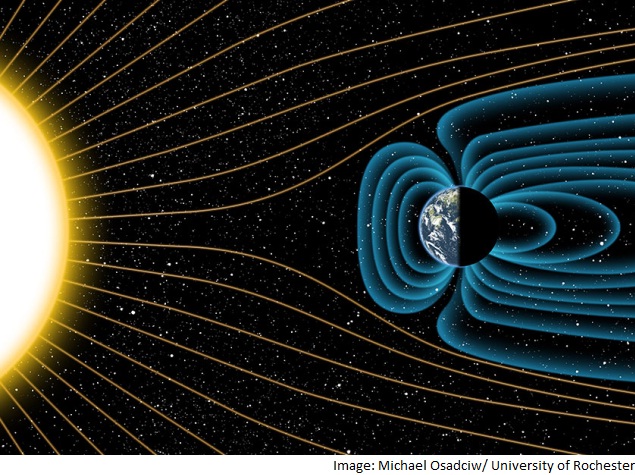- Home
- Science
- Science News
- Earth's Magnetic Field Much Older Than Previously Thought
Earth's Magnetic Field Much Older Than Previously Thought

Earth's magnetic field protects the atmosphere from solar winds - streams of charged particles shooting from the Sun. Earth's magnetic field is generated in its liquid iron core, and this "geodynamo" requires a regular release of heat
from the planet to operate. Today, that heat release is aided by plate tectonics, which efficiently transfers heat from the deep interior of the planet to the surface.
According to John Tarduno, a geophysicist at the University of Rochester, the time of origin of plate tectonics is hotly debated, with some scientists arguing that Earth lacked a magnetic field during its youth.
There are minerals - such as magnetite - that lock in the magnetic field record at the time the minerals cooled from their molten state.
The oldest available minerals can tell scientists the direction and the intensity of the field at the earliest periods of Earth's history. Tarduno's study was based on the record of magnetic field strength fixed within magnetite found within zircon crystals collected from the Jack Hills of Western Australia.
The ancient zircons are tiny - about two-tenths of a millimetre - and measuring their magnetisation is a technological challenge. Tarduno and his team used a unique superconducting quantum interference device, or Squid, magnetometer, at the University of Rochester that provides a sensitivity ten times greater than comparable instruments.
In order for today's magnetic intensity readings of the magnetite to show the actual conditions of that era, the researchers needed to make sure the magnetite within the zircon remained pristine from the time of formation.
Of particular concern was a period some 2.6 billion years ago during which temperatures in the rocks of the Jack Hills reached 475 degrees Celsius. Under those conditions, it was possible that the magnetic information recorded in the zircons would have been erased and replaced by a new, younger recording of Earth's magnetic field.
"We know the zircons have not been moved relative to each other from the time they were deposited," said Tarduno.
"As a result, if the magnetic information in the zircons had been erased and re-recorded, the magnetic directions would have all been identical," he said.
Instead, Tarduno found that the minerals showed varying magnetic directions, convincing him that the intensity measurements recorded in the samples were indeed as old as four billion years.
Tarduno also added that while there has been no consensus among scientists on when plate tectonics began, their measurements, however, support some previous geochemical measurements on ancient zircons that suggest an age of 4.4 billion years.
Catch the latest from the Consumer Electronics Show on Gadgets 360, at our CES 2026 hub.
Related Stories
- Samsung Galaxy Unpacked 2025
- ChatGPT
- Redmi Note 14 Pro+
- iPhone 16
- Apple Vision Pro
- Oneplus 12
- OnePlus Nord CE 3 Lite 5G
- iPhone 13
- Xiaomi 14 Pro
- Oppo Find N3
- Tecno Spark Go (2023)
- Realme V30
- Best Phones Under 25000
- Samsung Galaxy S24 Series
- Cryptocurrency
- iQoo 12
- Samsung Galaxy S24 Ultra
- Giottus
- Samsung Galaxy Z Flip 5
- Apple 'Scary Fast'
- Housefull 5
- GoPro Hero 12 Black Review
- Invincible Season 2
- JioGlass
- HD Ready TV
- Laptop Under 50000
- Smartwatch Under 10000
- Latest Mobile Phones
- Compare Phones
- OPPO Reno 15 Pro Max
- Honor Win RT
- Honor Win
- Xiaomi 17 Ultra Leica Edition
- Xiaomi 17 Ultra
- Huawei Nova 15
- Huawei Nova 15 Pro
- Huawei Nova 15 Ultra
- Asus ProArt P16
- MacBook Pro 14-inch (M5, 2025)
- OPPO Pad Air 5
- Huawei MatePad 11.5 (2026)
- Xiaomi Watch 5
- Huawei Watch 10th Anniversary Edition
- Acerpure Nitro Z Series 100-inch QLED TV
- Samsung 43 Inch LED Ultra HD (4K) Smart TV (UA43UE81AFULXL)
- Asus ROG Ally
- Nintendo Switch Lite
- Haier 1.6 Ton 5 Star Inverter Split AC (HSU19G-MZAID5BN-INV)
- Haier 1.6 Ton 5 Star Inverter Split AC (HSU19G-MZAIM5BN-INV)

















